Printable Version of Topic
Click here to view this topic in its original format
914World.com _ 914World Garage _ oil temp combo gauge bench testing
Posted by: malcolm2 Oct 14 2014, 09:00 PM
I have had this gauge for a while. I also found the complete taco plate, sender etc... to set it up. I decided to test it. I tested the sender a while back in hot water and remember getting various readings as the temp increased.
I pulled out my 12v powered drill battery, put 12v + on the + terminal of the gauge and the - on the - of the gauge. ( you can't see the - wire in the picture, but it is there)
The gauge moved to where it is in the picture without the sender even being connected. It did not move once the sender was connected.
Inside the temp gauge are the following #s. Far left 30, at the start of the red line 156.7 and the end of the red line 170 *C
The top of the paper is what is stamped on each face of the hex and the gauge part # has been edited to what you see in the picture.
1. why is the gauge moving at room temp with or with out the sender?
2. do I have this thing hooked up right? any alternate testing suggestions?
3. do I have a matched sender & gauge?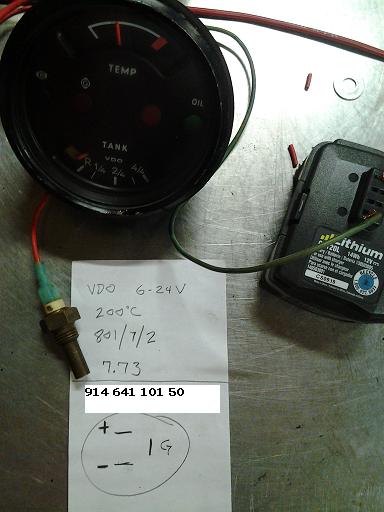
Posted by: bdstone914 Oct 14 2014, 09:10 PM
I have had this gauge for a while. I also found the complete taco plate, sender etc... to set it up. I decided to test it. I tested the sender a while back in hot water and remember getting various readings as the temp increased.
I pulled out my 12v powered drill battery, put 12v + on the + terminal of the gauge and the - on the - of the gauge. ( you can't see the - wire in the picture, but it is there)
The gauge moved to where it is in the picture without the sender even being connected. It did not move once the sender was connected.
Inside the temp gauge are the following #s. Far left 30, at the start of the red line 156.7 and the end of the red line 170 *C
The top of the paper is what is stamped on each face of the hex and the gauge part # has been edited to what you see in the picture.
1. why is the gauge moving at room temp with or with out the sender?
2. do I have this thing hooked up right? any alternate testing suggestions?
3. do I have a matched sender & gauge?

You should have a ground wire from the case of the sender to the ground of the battery. If you directly ground the sender wire it should peg the gauge. I can't explain why the gauge should register at ambient temp without the sender grounded. It looks like a metal table. Is the negative terminal of the gauge touching the table?
Posted by: malcolm2 Oct 14 2014, 09:34 PM
I have tried this set up on the car's battery too. +of the gauge to + of the car's batt. ground of the gauge to - of the car's batt. and the gauge moves and stays were it is in the picture. nothing I do to the sender causes any movement or change of the needle.
Posted by: malcolm2 Oct 15 2014, 05:32 AM
morning ![]()
Anyone know what is happening here?
Posted by: bdstone914 Oct 15 2014, 06:47 AM
Sounds like the gauge may be faulty. Did you try grounding the sender wire to see if it pegs the needle?
Posted by: malcolm2 Oct 15 2014, 06:53 AM
Sounds like the gauge may be faulty. Did you try grounding the sender wire to see if it pegs the needle?
Yes, I used a medium sized aligator clip. Clipped to the threads of the sender then to a nut on the engine. All this during the car battery test. The needle only wiggled slightly as the ground connection was being made.
Posted by: stugray Oct 15 2014, 08:11 AM
Sounds like the gauge may be faulty. Did you try grounding the sender wire to see if it pegs the needle?
Yes, I used a medium sized aligator clip. Clipped to the threads of the sender then to a nut on the engine. All this during the car battery test. The needle only wiggled slightly as the ground connection was being made.
I believe he means ground the sensor wire from the gauge.
This should peg the meter at ~300 deg.
Posted by: bdstone914 Oct 15 2014, 08:41 AM
Sounds like the gauge may be faulty. Did you try grounding the sender wire to see if it pegs the needle?
Yes, I used a medium sized aligator clip. Clipped to the threads of the sender then to a nut on the engine. All this during the car battery test. The needle only wiggled slightly as the ground connection was being made.
I believe he means ground the sensor wire from the gauge.
This should peg the meter at ~300 deg.
Yes.
Ground the terminal from the gauge directly. That will tell if the gauge responds correctly.
Posted by: malcolm2 Oct 15 2014, 09:40 AM
Ground the terminal from the gauge directly. That will tell if the gauge responds correctly.
Ah, I have not tried that. I'll try it this afternoon.
The "circle" in the picture is the back of the gauge showing the individual gauge wire connections.
+ of the gauge to + of a batt.
ground of the gauge to - of the batt
"G" of the gauge to ground.
If I do this on the car battery I can find a clean ground on the car and ground the "G". If I do it on the bench, should I use the - on the test battery?
If the NEEDLE does not peg to max, I have a gauge issue? That's what you are saying?
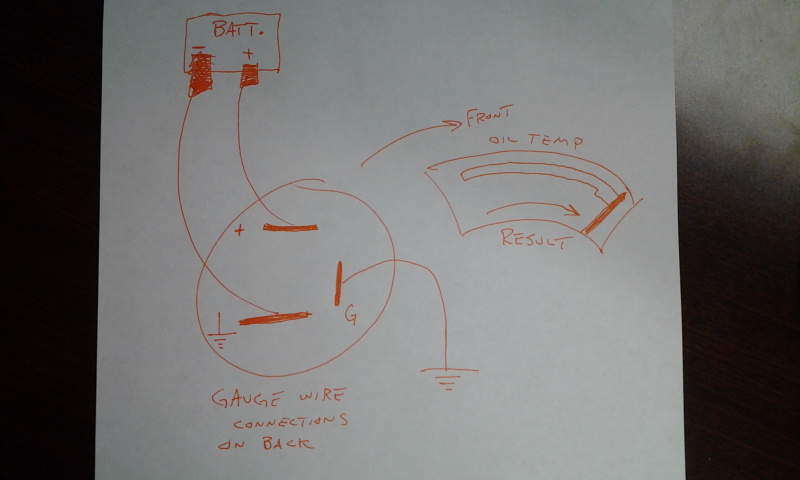
Posted by: bdstone914 Oct 15 2014, 09:57 AM
With either battery just jump from the G to - on the back of the gauge with the positive and negative wires connected to the battery. I think it will peg the gauge. It sounds like you gave a weak short to ground on the G terminal. Take that part of the gauge out and inspect it. You may have something touching the case and the G terminal. The gauge is responding to a signal when there should not be a signal.
Posted by: StratPlayer Oct 15 2014, 11:26 AM
So if the gauge pegs that means the gauge is good using this test?
Posted by: timothy_nd28 Oct 15 2014, 11:37 AM
For this gauge to act correctly, all wires need to be connected. The actual gauge part has a spring return with two sets of windings that are 90 degrees apart from one another. If the G terminal is not connected, the gauge will float because part of the windings are not biased properly. I didn't see anything out of the ordinary from your initial post, as the gauge behaved as it should with a missing G signal.
I recently integrated a temp gauge in a standard combo gauge for Rnellums, and even with the newer style gauge motors, it did the exact same thing,,because the G wire was floating. I don't think you have anything to worry about.
Bruce is correct when he explained how to bench test the gauge. By applying ground to the G terminal, the needle will deflect fully. It's a quick and easy test.
If you were to tie the sensor case to the gauge ground, then tie the sensors' isolated terminal to the G terminal, then finally tie power to the gauges + and - terminals, you should see everything work as it should. Then obtain a pot of deionized water, and dip your sender inside this pot while the water is boiling. It's a bunch of mickey mousing around, but a good way to see if your gauge is calibrated and trustworthy.
My wife gave me a crazy look, when I had my hands full of jumper wires attached to a car battery while on top of the kitchen stove. ![]() I told her that I was making a prototype cold fusion reactor!
I told her that I was making a prototype cold fusion reactor!
Posted by: malcolm2 Oct 15 2014, 11:47 AM
The gauge is responding to a signal when there should not be a signal.
Thanks Bruce, That is a good way to put it, I do understand that.
Last night I took the 4 screws out of that part of the gauge and removed it from the case. That is how I found the # along the top edge marking the beginning and the red section.
I reinstalled it, but I will remove it once more and take a closer look at the guts of this individual gauge.
And I will try your suggestion. It is alittle easier to just connect the G term. to the ground term on the back.
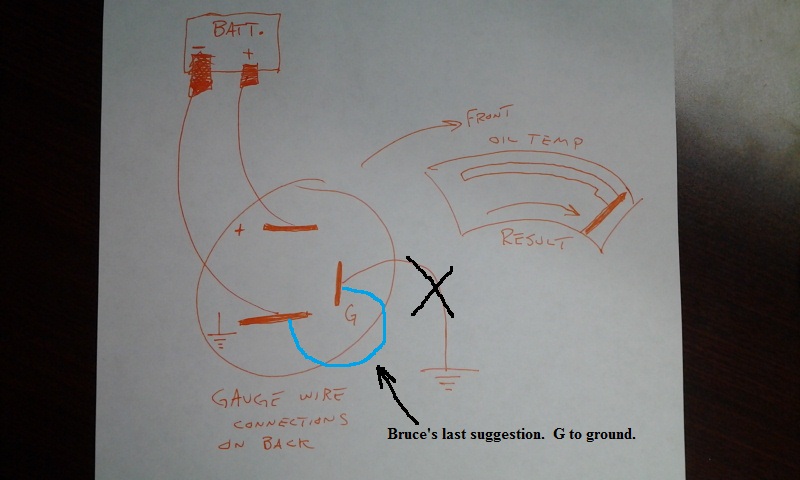
Posted by: timothy_nd28 Oct 15 2014, 11:54 AM
Closer look of the guts: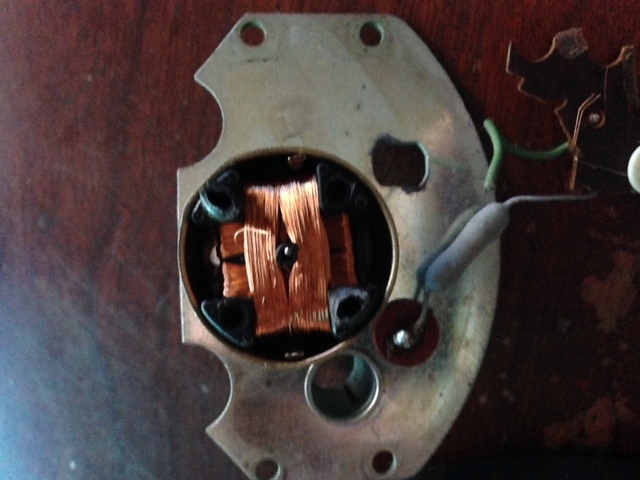
Posted by: malcolm2 Oct 15 2014, 12:21 PM
Closer look of the guts:
I just took it out, I did not crack it open. I'll go thru what you and Bruce have suggested before I do go too deep. fingers are crossed.
Thanks to all for the help..... so far.
Posted by: Dave_Darling Oct 15 2014, 01:30 PM
Just to make sure:
You know that the "G" on the back of the gauge does not stand for "ground", right? It's for "sender" (in German). So that terminal gets hooked up to the terminal on the back of the sender, and the threaded part of the sender gets hooked up to a ground. Like the ground terminal on the back of the gauge.
I'm just trying to make sure of the "did you turn it on" type of questions...
--DD
Posted by: malcolm2 Oct 15 2014, 05:18 PM
Just to make sure:
You know that the "G" on the back of the gauge does not stand for "ground", right? It's for "sender" (in German). So that terminal gets hooked up to the terminal on the back of the sender, and the threaded part of the sender gets hooked up to a ground. Like the ground terminal on the back of the gauge.
I'm just trying to make sure of the "did you turn it on" type of questions...
--DD
Process of elimination turned out to be pretty obvious. The connectors on the back are marked with a "+" and the international sign for ground which can't be typed with a qwerty key board and the the mystery "G". So what is the German word for SENDER? The fuel gauge has all the same markings.
I am home now and 'bout ready to give the suggested test method a try. Maybe one more
Posted by: malcolm2 Oct 15 2014, 06:26 PM
![]()
I need to thank everyone for their help and comments and support. Everything has proven successful.
The needle did peg to the right when i placed a jumper from the ground terminal to the "G" terminal while supplying 12v + and - to the proper terminals. The green wire goes to the ground term. the single red goes to the + term and the red with the green is the jumper to the "G"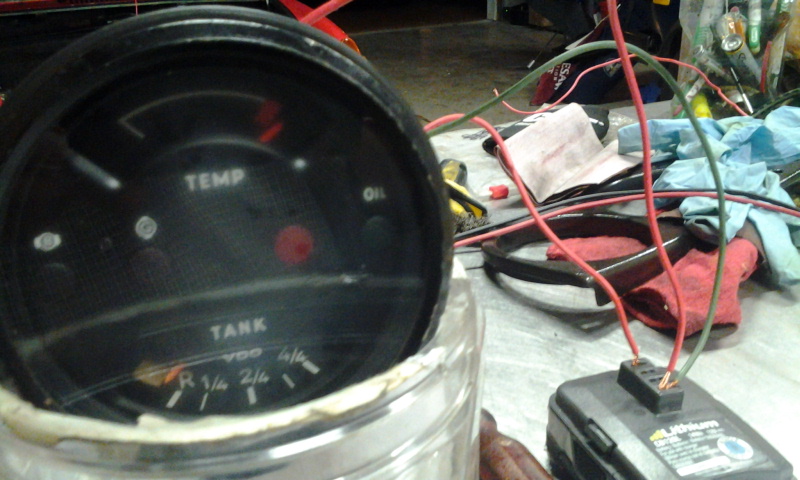
And the sender in boiling water test has given me a reference for 212* F.... Probably a little too close to the red line for my taste, but I guess I will get used to it.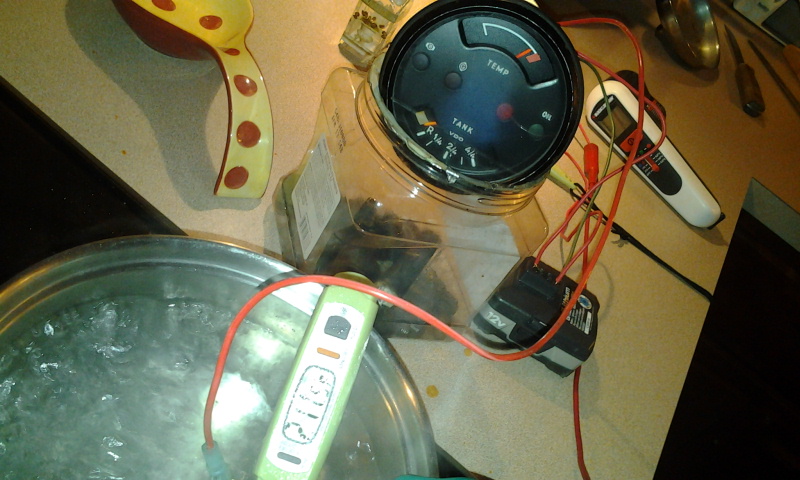
Posted by: timothy_nd28 Oct 15 2014, 06:43 PM
I'm not sure where the needle should point at 212 degree's F. I think it's too close to the red mark for such a low temp. If you buy a 1k potentiometer from your local radio shack, you could wire it in series with the sender. Perform the test again, and adjust the pot till the needle is somewhere in the middle. Then if you carefully remove the pot from the circuit and measure the resistance, you could buy a fixed resistor with that value and hard wire it in the circuit.
Just a thought
Posted by: Mblizzard Oct 15 2014, 07:44 PM
Anyone figure out Clark is an engineer?
I know some of the other gauges have some reference values printed al g the very top part of the gauge. Not sure if the combo is the same.
Posted by: malcolm2 Oct 16 2014, 06:29 AM
Anyone figure out Clark is an engineer?
I know some of the other gauges have some reference values printed al g the very top part of the gauge. Not sure if the combo is the same.
This one does have those numbers. you need to take it out to see them and they are in Celsius. The red line starts at 156.7 then there is a slight tick mark 1/2 way across the red for 170.
Thanks for the vote of confidence, but i am the type of engineer that the other engineers make jokes about, an industrial engineer.
Posted by: malcolm2 Oct 20 2014, 09:15 PM
I'm not sure where the needle should point at 212 degree's F. I think it's too close to the red mark for such a low temp. If you buy a 1k potentiometer from your local radio shack, you could wire it in series with the sender. Perform the test again, and adjust the pot till the needle is somewhere in the middle. Then if you carefully remove the pot from the circuit and measure the resistance, you could buy a fixed resistor with that value and hard wire it in the circuit.
Just a thought
Hey Tim, I am back at it......I bought the 1k potentiometer and I get zero needle movement. I ran the pot screw thru all 15 turns and measured ohms from 0 to 1.5 on the continuity scale.
3 terminals on the pot. I put the wire from the sender to, let's say, the right term on the pot, then from the middle terminal on the pot to the gauge.
The gauge was all powered up like above and the gauge needle was nearly 1/2 way.
Do I need more resistance, a 20K or 100k pot?
I wonder if Bruce is correct about a short in the gauge giving me more resistance at room temp. I did not see anything touching the "G" when I opened it up.
Clark
Posted by: timothy_nd28 Oct 20 2014, 10:04 PM
You should test the potentiometer first. Measure the total resistance of the pot by checking the outer terminals, it should measure 1k (1000) ohms.
If this checks out fine, then put one meter lead to the middle pin, and the other meter lead on one of the 2 remaining pins (you choose). The pin that is not used, go ahead and bend it over so you don't get confused with it later. With the multimeter still on the resistance setting, observe what it is reading. Then turn the potentiometer fully in one direction, it will either read zero or 1000 ohms. Go ahead and turn it so it reads 0 ohms,,essentially a shorted state.
If all of the above checks out, and the potentiometer is calibrated to 0 ohms, continue to the next step.
As in post number 18, set it up the same exact way. The sensor casing is ground, and should share the same ground as the gauge ground and battery ground. The terminal on the sensor should be wired straight to the G terminal. Go ahead and boil a pot of water and verify everything still works as it did in post 18.
If all checks out and works like it did earlier, then wire in the potentiometer. The terminal from the sensor needs to be wired to the middle pin on the pot. The other pin of the potentiometer needs a wire going to the G terminal on the gauge. With your multimeter, measure the resistance from the G terminal on the gauge to the terminal on the sensor. You should read 0 ohms.
Now boil some water, and insert your sensor into this bath of water. Be sure that the sensor doesn't touch the sides or bottom of this boiling pot of water. You gauge should still reach the same red mark as you showed us in post #18.
Now, adjust the potentiometer, by adding resistance, you should see the needle back off from the red mark.
Posted by: timothy_nd28 Oct 20 2014, 10:19 PM
I just did a quick Google search and it looks like the sensor for the combo temp gauge has a resistance of 3000 ohms (cold) to 1000 ohms (hot).
So the 1k pot that you bought should be about perfect. This is only temporary, as we are using this as a trim pot. After you adjust the pot to where you like the needle placement, go ahead and remove the potentiometer from the circuit and measure the resistance. Whatever you read, you will need to buy a 1/2 watt resistor that is close to that reading.
Posted by: malcolm2 Oct 21 2014, 07:07 AM
You should test the potentiometer first. Measure the total resistance of the pot by checking the outer terminals, it should measure 1k (1000) ohms.
If this checks out fine, then put one meter lead to the middle pin, and the other meter lead on one of the 2 remaining pins (you choose). The pin that is not used, go ahead and bend it over so you don't get confused with it later. With the multimeter still on the resistance setting, observe what it is reading. Then turn the potentiometer fully in one direction, it will either read zero or 1000 ohms. Go ahead and turn it so it reads 0 ohms,,essentially a shorted state.
If all of the above checks out, and the potentiometer is calibrated to 0 ohms, continue to the next step.
As in post number 18, set it up the same exact way. The sensor casing is ground, and should share the same ground as the gauge ground and battery ground. The terminal on the sensor should be wired straight to the G terminal. Go ahead and boil a pot of water and verify everything still works as it did in post 18.
If all checks out and works like it did earlier, then wire in the potentiometer. The terminal from the sensor needs to be wired to the middle pin on the pot. The other pin of the potentiometer needs a wire going to the G terminal on the gauge. With your multimeter, measure the resistance from the G terminal on the gauge to the terminal on the sensor. You should read 0 ohms.
Now boil some water, and insert your sensor into this bath of water. Be sure that the sensor doesn't touch the sides or bottom of this boiling pot of water. You gauge should still reach the same red mark as you showed us in post #18.
Now, adjust the potentiometer, by adding resistance, you should see the needle back off from the red mark.
With the exception of boiling the water again and MAYBE the bolded statement above. That is what I did. I am thinking I put the lead from the sensor on one of the outer terminals of the pot, but I am not positive. I'll double check that this evening.
Why wouldn't the needle move with the pot. a room temp? I was measuring as I moved the pot and got a reading that was much higher than the reading I got from the sensor at room temp..... 1.8 on the continuity setting. IIRC I got 1.3 at room temp with no pot attached.
I did document the sensor's readings at different temps up to 212.
I'll run thru your test scenario tonight.
Thanks for your input.
Posted by: timothy_nd28 Oct 21 2014, 12:05 PM
The boiling water is key for this setup. The potentiometer is adding resistance, which will only drive the needle counter clockwise. If the sensor is at room temp, the needle is already maxed out at cold, adjusting the potentiometer at this point will not have any effect on the needle, because the needle can't move any further in that one direction.
Be sure the potentiometer is calibrated for zero ohms, before you perform this test later tonight. When the sensor is in the boiling water, adjust the potentiometer just a tiny bit, my guess is that your adjustment will be between 1/2 to a full turn. It shouldn't take much.
Posted by: malcolm2 Oct 21 2014, 12:46 PM
If the sensor is at room temp, the needle is already maxed out at cold, adjusting the potentiometer at this point will not have any effect on the needle, because the needle can't move any further in that one direction.
That makes sense. But did not seem logical since the location of the needle, when the gauge is disconnected, is further to the left. I assumed I could "push" the needle more to the left....while connected and at room temp.
Should be easy to try your suggestion,
Clark
Posted by: ClayPerrine Oct 21 2014, 12:56 PM
Has anyone noticed that there is no ground return wire from the sender that is in the water? None of the pictures show it.
If you don't ground the sender, all of your tests will be incorrect.
Posted by: malcolm2 Oct 21 2014, 01:10 PM
Has anyone noticed that there is no ground return wire from the sender that is in the water? None of the pictures show it.
If you don't ground the sender, all of your tests will be incorrect.
Shot is not wide enough but if the grounds were not connected the gauge would not move as the sender got hot. it is there, i promise. This was the test to see where the gauge was at 212*F. Next is to get it to were it needs to be at 212*F which is just past half way.
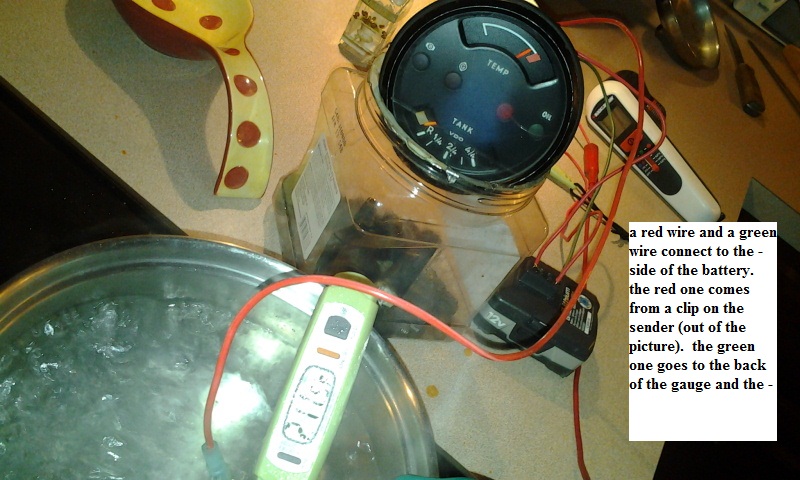
hidden clip... follow the yellow line to the other clip,,,, to the red wire, behind the gauge to the battery.
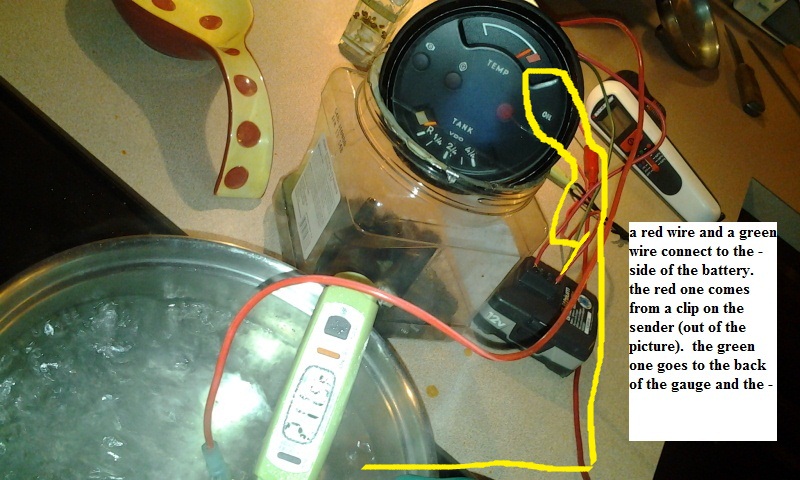
Posted by: malcolm2 Oct 21 2014, 06:10 PM
Tim, you need an award. ![]()
![]() It worked. I am a good direction follower too.
It worked. I am a good direction follower too.
5 minute video of watching water boil.
https://www.youtube.com/watch?v=P1Ld8urUl7c
I am not totally out of the woods yet tho. I assumed that this process would shift the range of motion of the needle to include more of the left (cold) half of the gauge while it put the needle in the correct place at 212*F.
It looks like it only changed the right half of the range of motion. when it all went back to room temp the needle was pretty much where it was from the start.... about 1/3 up the dial, pointing "thru" the E. making my range from room temp to 212 from the left edge or the E to the middle of the M.
Was that what you expected? ![]()
Posted by: timothy_nd28 Oct 21 2014, 06:36 PM
A couple of things:
You can't measure resistance while everything is powered up.
Next, the meter is on the wrong setting. You are on some diode test setting, you should move the selector knob to 2k range when measuring. Do this when power is removed.
Posted by: malcolm2 Oct 21 2014, 07:07 PM
A couple of things:
You can't measure resistance while everything is powered up.
Next, the meter is on the wrong setting. You are on some diode test setting, you should move the selector knob to 2k range when measuring. Do this when power is removed.
OK, I made the correction, did the boil again.
set the pot to 0
at boil, moved the pot to adjust the needle to my estimated 212 location
checked the ohms from the middle of the pot to the outer terminal: 0.225 on the 2k setting measured free and clear of any power.
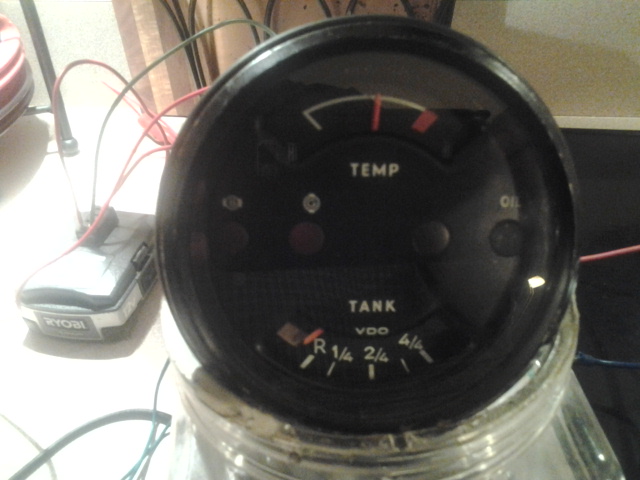
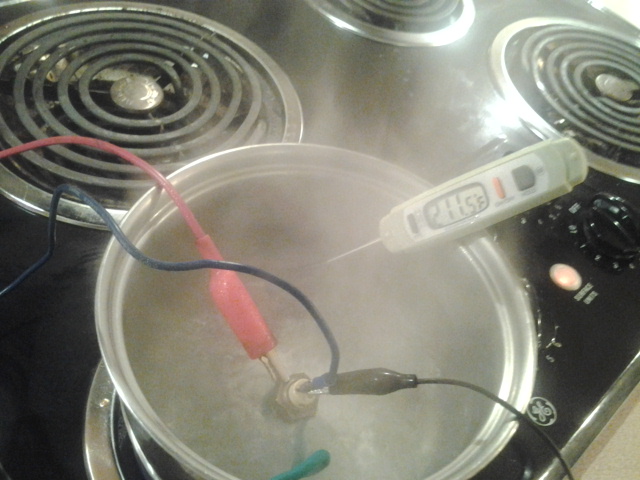
And this is at ROOM TEMP
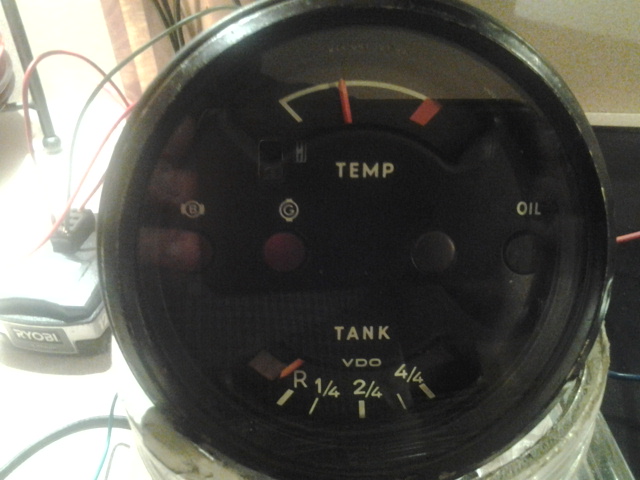
Posted by: stugray Oct 21 2014, 07:08 PM
This is about all you ever need on this topic:
http://www.914world.com/bbs2/index.php?showtopic=97987
Thank you McMark.
It even explains "the readout of both gauges is exactly the same, and Porsche redesigned the gauge because owners were nervous/cautious/concerned about the normal operating temperature was 'too close' to the red on the early gauges"
Posted by: timothy_nd28 Oct 21 2014, 07:15 PM
what is the resistance of the sensor when at room temperature?
Posted by: malcolm2 Oct 21 2014, 07:18 PM
This is about all you ever need on this topic:
http://www.914world.com/bbs2/index.php?showtopic=97987
Thank you McMark.
It even explains "the readout of both gauges is exactly the same, and Porsche redesigned the gauge because owners were nervous/cautious/concerned about the normal operating temperature was 'too close' to the red on the early gauges"
That is a good post, but it does not deal with my issue.
the left most point of the red mark represents 156.7*C or 314*F. In boiling water, my needle is on what seems to be 300*F, just a short distance from that edge of the red mark. the actual temp of the sensor when in boiling water is 100* C or 212*F. I estimate that to be just past 1/2 way thru the range of the whole gauge: from the left white tick to the leading edge of the red.
Posted by: malcolm2 Oct 21 2014, 07:26 PM
what is the resistance of the sensor when at room temperature?
I made those measurements last night.... at about 85*F and the meter is on 2K. One probe is on the terminal and the other is on the brass nut of the sensor.
I got a reading of 1.800. I just verified that number.
Posted by: timothy_nd28 Oct 21 2014, 07:51 PM
Sorry, was unaware that the needle was not traveling to the cold mark, thought we resolved this earlier by grounding the sensor's casing. I think your sensor maybe out of tolerance. Let's try bench testing once again, the same way but not with the boiling water this time.
Adjust your potentiometer to 1000 ohms, instead of 0. You should now have a total resistance of 2800 ohms at room temperature (measuring from the sensors' case to the G terminal on the back of the gauge). Power it up and see if the needle moved any closer to the cold position.
Posted by: malcolm2 Oct 21 2014, 08:10 PM
Sorry, was unaware that the needle was not traveling to the cold mark, thought we resolved this earlier by grounding the sensor's casing. I think your sensor maybe out of tolerance. Let's try bench testing once again, the same way but not with the boiling water this time.
Adjust your potentiometer to 1000 ohms, instead of 0. You should now have a total resistance of 2800 ohms at room temperature (measuring from the sensors' case to the G terminal on the back of the gauge). Power it up and see if the needle moved any closer to the cold position.
it is actually about 3 mm closer to the left WITHOUT the pot in the circuit. I tried it in line then took the pot out, re-connected and it dropped (moved left) a smidge when re-connected.
update: measuring from the sensors case to the G term with the pot in line and the meter on 2K I get .242.
2nd update: I made a circuit from the terminal of the sensor thru the pot (at 1000 ohms) and checked it at room temp. meter on 20K setting, I read 3.2.... remove the pot and I read 2.2. Seems logical.
Posted by: stugray Oct 22 2014, 12:11 AM
what is the resistance of the sensor when at room temperature?
I believe that the sensor is a type 2252 thermistor.
2250 Ohms at 25 C (77F)
153 ohms at 100C (212F)
42 ohms at 150C (300F)
So I am not quite grasping what inserting a series resistor in the circuit will do.
When the oil reaches temp ~240 F = 115C = sensor is 100 ohms.
If you put a 1000 ohm series resistor in line, then when the sensor is at 240F it will be 100 Ohms and the gauge will see 1100 Ohms which it will think is 42C (107F).
So all the series resistor can do is decrease resolution?
I think I will break out my spare parts as well.
I have to figure out how this works to tap my datalogger into the temp sensor anyway.
Posted by: malcolm2 Oct 22 2014, 11:54 AM
So I am not quite grasping what inserting a series resistor in the circuit will do.
When the oil reaches temp ~240 F = 115C = sensor is 100 ohms.
If you put a 1000 ohm series resistor in line, then when the sensor is at 240F it will be 100 Ohms and the gauge will see 1100 Ohms which it will think is 42C (107F).
So all the series resistor can do is decrease resolution?
Tim was trying to make the gauge go to the right place at a known temperature. It seems that the sensor is doing what it is supposed to, but the gauge is off. So I assume we were faking out the gauge pumping some additional ohms into the system to move the needle to 100*C. It worked. I got the gauge to where I estimated 100*C was. It just did not completely fix my gauge.
This post is on hold for a while. I am getting extra help from Tim on this. He has a theory or two he is going to try..... more to come.
Posted by: malcolm2 Nov 24 2014, 07:18 PM
This post is on hold for a while. I am getting extra help from Tim on this. He has a theory or two he is going to try..... more to come.
The results are back
and the old gauge guts have been replaced with the guts of a new VDO gauge. Sender is in boiling water 212*F. The left edge of the red is 314*F.
For comparison the VDO face plate is in the picture, just laying on the gauge, it is not PART of the gauge. The needle seems to have moved very close to the 200 on that dial (10 mm on both) as expected.
Tim is awesome
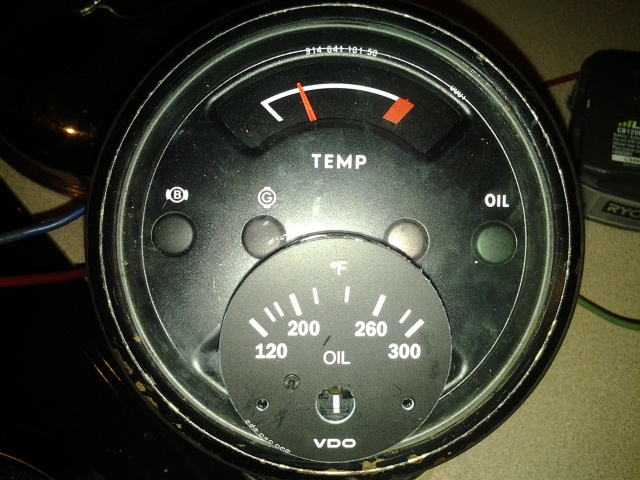
Powered by Invision Power Board (http://www.invisionboard.com)
© Invision Power Services (http://www.invisionpower.com)
